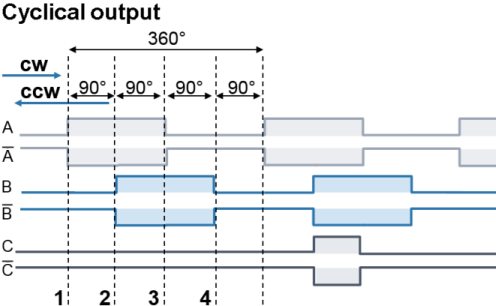Incremental encoder basics
Incremental encoders divide a 360° rotation of the encoder axis into individual steps (increments) and mark a full revolution by means of a special mark (zero pulse). An RS422 encoder transmits the signal symmetrically as a differential line pair. TTL and Open Collector encoders use single signal lines (single-ended).
The module evaluates the 90° phase-shifted square wave signals of an incremental encoder on tracks A and B. The zero pulse is captured on track C. With a differential connection, the inverted signals (A̅, B̅, C̅) are also recorded.
These signals are converted by means of the quadrature decoder and the 32-bit counter into a position value with optional quadruple, double or single evaluation. The digital inputs enable latch, reset and set functionalities and thus exact and speed-independent referencing and storage of the counter value.
Encoder type | Incremental signals | |
|---|---|---|
RS422 encoder | with zero pulse | A, A̅, B, B̅, C, C̅ |
RS422 encoder | without zero pulse | A, A̅, B, B̅ |
RS422 counter or pulse generator | with zero pulse | A, A̅, C, C̅; counting direction specification via track B (B, B̅) |
RS422 counter or pulse generator | without zero pulse | A, A̅; counting direction specification via track B (B, B̅) |
TTL, Open Collector encoder | with zero pulse | A, B, C |
TTL, Open Collector encoder | without zero pulse | A, B |
TTL, Open Collector counter or pulse generator | with zero pulse | A, C; counting direction specification via B |
TTL, Open Collector counter or pulse generator | without zero pulse | A, counting direction specification via B |
The phase position between the signals at track A and track B determines the counting direction.
Forward (cw): signal at track A is 90° leading with respect to track B
Backward (ccw): signal at track A is 90° lagging compared to track B.
With 1-fold evaluation the rising edges on track A are counted.
With 2-fold evaluation, the rising and falling edges on track A are counted.
With 4-fold evaluation, the rising and falling edges on track A and track B are counted.
 Fig.5: Incremental signals
Fig.5: Incremental signalsAbsolute value encoders provide an absolute position value directly after switch-on, which is unambiguous over the entire travel path. With incremental encoders, a homing must be carried out after switching on in order to be able to determine a unique position.
Homing can be carried out, for example, with the aid of referencing cams or via the zero pulse of the encoder.
Notice | |
Differential and single-ended connection The RS422 signal transmits a differential voltage, which makes the signal less sensitive to interference compared to a single-ended signal.
|